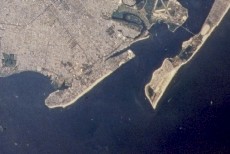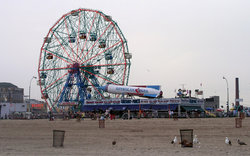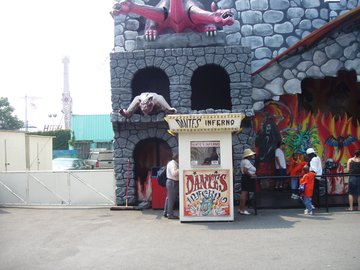Coney Island
|
|
- This article is about about Coney Island in New York City. For the restaurant, see Coney Island (restaurant).

Coney Island is a peninsula and former island of southernmost Brooklyn, New York City, with a famous beach lying on the Atlantic Ocean.
The neighborhood called Coney Island is a community of 60,000 people in the western part of the peninsula, with Sea Gate to its west, and Brighton Beach and Manhattan Beach to its east. To the north is Gravesend.
The area was formerly a major resort and home of amusement parks, reaching its peak in popularity in the early 20th century but declining after World War II. In recent years, the area has been revitalized by Russian immigrants and the opening of KeySpan Park, home to the successful Brooklyn Cyclones minor league baseball team.
| Contents |
The Island
Geologically, Coney Island is the westernmost of the barrier islands of Long Island, about four miles long and one-half mile wide. It was formerly an actual island, separated from the main part of Brooklyn by Coney Island Creek, part of which was little more than tidal flats. There were plans into the 20th century to dredge and straighten the creek as a ship canal, but these plans were abandoned and the center portion of the creek was filled in for construction of the Belt Parkway before World War II. The western and eastern ends are now peninsulas.
History
The Name
There are a number of explanations for Coney's name, but the generally accepted source is from coney, an obsolete English word for rabbit, chosen because it was cognate with the Dutch name for the island, Coneyn Eilant ("Rabbit Island"). It has been called thus since the 1640s, appearing on early maps of Nieuw Amsterdam as such.
The Native American inhabitants of the area called the island Narrioch, "land without shadows", because, in common with other south shore Long Island beaches, its compass orientation keeps the beach area in sunlight all day. In common with other Long Island barrier islands, Coney Island was virtually overrun with rabbits, and rabbit hunting was common until resorts were developed and open space eliminated.
The Resort
Beginning with the period after the Civil War, Coney Island became a resort, as excursion railroads and the Coney Island & Brooklyn Railroad streetcar line reached the area in the 1860s and 1870s. With the rail lines, steamship lines and access to the beach came major hotels and public and private beaches, followed by horse racing, amusement parks, and less reputable entertainments, including three card monte and other gambling entrepreneurs, and prostitution.
When the steam railroads were electrified and connected to Manhattan via the Brooklyn Bridge by the Brooklyn Rapid Transit Company at the beginning of the 20th century, Coney Island began to turn more rapidly from a resort to an accessible location for day-trippers seeking to escape the summer heat in New York City's tenements.
The first carousel at Coney Island was built in 1876 by Charles I. D. Looff, a Danish woodcarver. It was installed at Vandeveer's bath-house complex at West 6th Street and Surf Avenue. The complex was later called Balmer's Pavilion. The carousel consisted of hand-carved horses and animals standing two abreast. A small coach was mounted on the platform for people to sit in who didn't want to ride the horses. The ride was illuminated with kerosene lanterns (Thomas Edison did not announce his first light bulb until three years later, in 1879). Music was provided by two musicians, a drummer and a flute player. A metal ring-arm hung on a pole outside the ride feeding small, iron rings for eager riders to grab. A tent-top protected the riders from the weather. The fare was five cents.
P7220062.JPG
Nathan's Famous' original hot dog stand opened on Coney Island in 1916, and quickly became a landmark there. Their celebrated annual hot dog eating contest has been held there since its opening.
In 1915 the Sea Beach Line was upgraded to a subway line, followed by the other former excursion roads, and the opening of the New West End Terminal for all the subway lines in 1919 ushering in Coney Island's busiest era.
After World War II contraction began seriously from a series of pressures. Air conditioning in movie theaters and then homes, and the advent of automobile access to less crowded and more appealing Long Island state parks, and especially Jones Beach lessened the attractions of Coney's beaches. Luna Park closed in 1946 after a series of fires and the street gang problems of the 1950s, now colorfully portrayed, spilled over into Coney Island. Though there was not a great danger as would be understood today, the menacing appearance of some of the youth, and their often harassing behavior made parents less willing to bring their young children to Coney or allow their teenaged children to go there.
The presence of threatening youth did not impact the beachgoing so much as it discouraged visits to rides and concessions, the staples of the Coney Island economy. A major blow was struck in 1964 when Steeplechase Park, the last of the major parks, closed.
The builder and New York City Parks Commissioner Robert Moses was actively opposed to the "tawdry" entertainment at Coney and discouraged new building of amusement. Housing projects (both low and moderate income) were built that used up what had been amusement areas, and the aquarium project, where Dreamland once stood, helped contract the available area for more traditional amusements.
In Coney Island's lowest years there was some incremental improvement in relatively small areas, notably the preservation and later the expansion of what had been the rides area at the back of the Feltman's property as Astroland. The general improvement in New York City's infrastructure, commercial prospects and image after the 1970s fiscal crisis under the mayoral administration of Edward I. Koch helped Coney Island, and many improvements were made under the recent mayoralty of Rudolph Giuliani, continuing with the current mayor, all helped by the Wall Street booms of the 1980s and 1990s.
While all of the original amusement parks have long since closed down, Steeplechase being the last in 1964, one revived amusement park, Astroland, has gradually expanded, and there are also several more or less organized amusement areas and a number of independent rides and concessions.
The Coney Island Amusements
Between about 1880 and World War II, Coney Island was the largest amusement area in the United States, attracting several million visitors per year. At its height it contained three competing major amusement parks, Luna Park, Dreamland, and Steeplechase Park, as well as many independent amusements. It was finally eclipsed by Disneyland in California.
Rides
The amusement area contains various rides, games such as skeeball, and a sideshow, games of shooting and throwing and tossing skills. Record setting Coney Island rides (as the first of their kind or largest) are:
- Wonder Wheel (1920), a huge ferris wheel with both stationary cars and moving cars that run on tracks, now part of Deno's Wonder Wheel Amusement Park;
- The Cyclone roller coaster (1927), which some claim is still the world's largest wooden roller coaster;
- Parachute Jump, originally the Life Savers Parachute Jump at the 1939 New York World's Fair, which was the first ride of its kind. Patrons were hoisted some 190 feet in the air before being allowed to drop using guy-wired parachutes. This landmark ride, closed for years, was completely dismantled, cleaned, painted and restored, but there are varying opinions on whether it should reopen as a ride, or stand as a symbolic structure;
- Bumper cars, which are small vehicles with rubber bumpers all the way around, which ride on a flat metal surface, and are powered by electricity conducted by a pole standing upright from the back of the car and touching an electrified ceiling. The electrical ground is provided by the metal flooring. The object is to ride in a loop and bump other cars, especially if you are a young male and there are rival young males in another car, or better, pretty young girls. The idea for the Demolition Derby is said to have originated from bumper cars.
Other Parks and Venues
It is also the location of the New York Aquarium since June 6th, 1957, on the former site of the Dreamland amusement park. In 2001, KeySpan Park opened on the former site of Steeplechase Park to host the Brooklyn Cyclones minor-league baseball team.
Since the early 80's Coney Island has been the home of Coney Island, USA - a not for profit arts organization "dedicated to preserving the dignity of American Popular Culture." Coney Island, USA produces the last 10-in-1 Sideshow in America at their theater on Coney Island. The organization also produces the annual Mermaid Parade, the Coney Island Film Festival, and houses the Coney Island Museum. Thanks largely to the efforts of the group, Coney Island has seen a rebirth in the early 2000's, with many new New Yorkers rediscovering the joy of this beautiful waterfront treasure that's just a subway ride from Manhattan.
An annual (and revealing) amateur mermaid parade takes place on Surf Avenue, featuring floats, acts, and various entertainments, some rivaling the more famous Halloween parade in Greenwich Village.
Swimming and Sunbathing
Coney Island's excellent and sun-drenched beach remains a major attraction. The main beach area, extended from Coney Island Avenue in Brighton Beach westward to West 37th Street at the border of Sea Gate, is divided into "bays," areas of beach delineated by rock jetties, which moderate erosion and the force of ocean waves. The length of this beach is occupied by the Riegelman boardwalk, reputed to be the world's longest, and the subject of the famous song "Under the Boardwalk," first popularized in 1964.
The Polar Bear Swim Club first met at Coney Island and make an annual pilgrimage in the dead of winter to swim in the icy ocean waters, accompanied by bundled up television reporters.
The communities
Coney-Island-Boardwalk.jpg
The neighborhoods on Coney Island, running from west to east are Sea Gate (a private community), Coney Island proper (called West Brighton until the 20th century), Brighton Beach, Manhattan Beach and Oriental Beach.
Sea Gate is one of only two neighborhoods in New York City where the streets are owned by the residents and not the city; it is cordoned off by a fence and gate houses.
Its main subway station is called Stillwell Avenue and can be reached by the Template:NYCS D, Template:NYCS F, Template:NYCS N and Template:NYCS Q train lines of the New York City subway system. The three main avenues in the Coney Island community (as opposed to the island itself), are (north to south) Neptune Ave., which crosses to the mainland to become Emmons Ave., Mermaid Ave. and Surf Ave., which becomes Ocean Parkway and then runs north to Brooklyn's Prospect Park.
The cross streets in the Coney Island neighborhood proper are numbered with "West" prepended to their numbers, running from West 1st Street to West 37th Street at the border of Sea Gate.
The majority of the population of Coney Island resides in approximately thirty 18 to 24 story towers, mostly comprised of various forms of public housing. In between the towers are many blocks that are filled with burned out and vacant buildings. Once home to many Jewish and Italian-American residents, most of those living on Coney Island today are African American or Hispanic. In recent decades a large influx of Russian immigrants from the former Soviet Union, many of them Jewish, have also established a community on the island and neighboring Brighton Beach, with many shop signs now in both Russian and English, earning the nickname "Little Odessa".
See also
External links
- Satellite Image of Coney Island (http://www.terraserver.com/imagery/image_gx.asp?cpx=-73.97421083&cpy=40.57769721&res=16&provider_id=305&t=pan)
- Coney Island, USA Home Page (http://www.coneyislandusa.com)
- Coney Island Thunderbolt (http://home.nyc.rr.com/johnmiller/ci_tbolt.html)
- contemporary photos of Coney Island (http://www.joyrides.com/coney_island/index.htm)
- John A. Miller home page (http://home.nyc.rr.com/johnmiller/index.html)
- Coney Island Lighthouse (http://www.coneyislandlightstation.com)
- 2004 Mermaid Parade (http://www.forgotten-ny.com/mermaid2004/mermaid2004.html) at Forgotten New York
- Coney Island Mermaid Parade Photos (http://www.isidore-of-seville.com/mermaids/28.html)de:Coney Island


